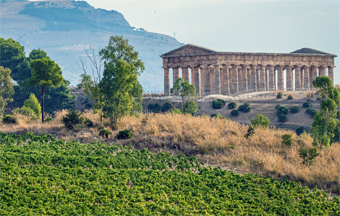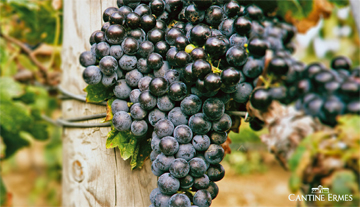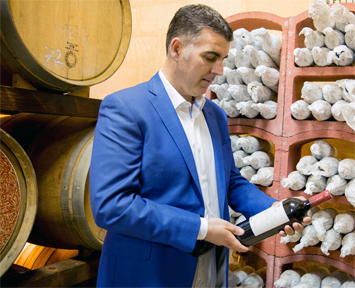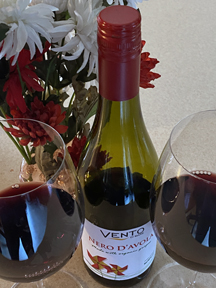Cantine Ermes
(An Online Virtual Visit)
by
Terry Sullivan
Photos provided by
Cantine Ermes unless otherwise noted.
This article about Cantine Ermes is based on an online interview, online data and photos supplied by the winery. The winery graciously sent two samples of wine. The article was written during the time of the worldwide 2020-2022 pandemic. Rosario Di Maria, President of Cantine Ermes, responded to our questions and supplied the photos.
 Summary: Destruction and reconstruction summarize the resilience of the land, people and grapes. In January of 1968, an earthquake on the island of Sicily destroyed several villages. A group of grape growers fought back by replanting, rebuilding and founding Ermes Winery. Today, Cantine Ermes produces wine with both indigenous and international grapes.
Summary: Destruction and reconstruction summarize the resilience of the land, people and grapes. In January of 1968, an earthquake on the island of Sicily destroyed several villages. A group of grape growers fought back by replanting, rebuilding and founding Ermes Winery. Today, Cantine Ermes produces wine with both indigenous and international grapes.
The cooperative on Sicily is impressive. There are 2,373 associates who range in age from 15 to over 70. These associates cultivate 12,648 hectares (about 31,254 acres) of grapes. Cantine Ermes operates 11 cellars. Rosario Di Maria shared some of the philosophy and history of the winery.
“The history of Cantine Ermes and Valle del Belìce is a fundamental part of our philosophy and of our way of making wine. Since 1968, after an earthquake, our land has totally changed: our fathers improved the viticulture and we started to study the soils, the climate, the exposures. In 1998 Cantine Ermes began to operate, thanks to the driving force of 9 small winemakers. In our philosophy, the winemakers (today we are 2,373) are the most important people. People who work under the sun and know every detail of the vineyard. Thanks to them, we can make good wines with a good quality/price ratio.”
During the past twenty years, Cantine Ermes continued to grow. Now, the winery produces about twelve million bottles of wine. In 2008 the company started a collaboration with a company in Veneto, now it is part of Cantine Ermes. In 2018, the company expanded to Apulian viticulture. Today, Cantine Ermes is one of the largest wine cooperatives in Italy.
Vineyards
 Vineyards are located in three Italian regions: Sicily, Puglia and Veneto. In each region both international grapes and indigenous grapes are cultivated. For example native grapes such as Nero D’Avola are grown in Sicily, Glera in Veneto and Primitivo in Apuila. The terroir is different in each vineyard location. Those vineyards in Sicily benefit from the most sunshine and wind in Europe. With so many vineyards, Cantine Ermes can match grapes for a wine they want to craft.
Vineyards are located in three Italian regions: Sicily, Puglia and Veneto. In each region both international grapes and indigenous grapes are cultivated. For example native grapes such as Nero D’Avola are grown in Sicily, Glera in Veneto and Primitivo in Apuila. The terroir is different in each vineyard location. Those vineyards in Sicily benefit from the most sunshine and wind in Europe. With so many vineyards, Cantine Ermes can match grapes for a wine they want to craft.
The winemaking team and the growers work together. The winemaking team visits the vineyards throughout the year. Growers and winemakers decide on when to harvest the grapes and the grapes are checked when arriving at the winery.
For growers, membership in a cooperative has advantages. One advantage is not having to purchase winemaking equipment and supplies. Another advantage of working together is that the cooperative provides advice, help and support. One direction vineyards are going into is organic farming. As of 2022, 2,878 hectares (7,111 acres) are farmed organically.
Winemaking
The large cooperative has ten winemakers. The head winemaker is Giuseppe Clementi. He enjoys working with different grapes and having those grapes express their terroirs.
 Rosario (pictured right) would like people to know that the entire staff at Cantine Ermes are ordinary people with a passion for the grapes they grow and the wines they make. For the past two decades the group has grown and evolved into one of Italy’s largest wine cooperatives. Rosario wrote, “The consolidation of the winery is important for the whole territory: growers, workers, suppliers, there are more or less 3,000 people who have a salary thanks to the success of Cantine Ermes.”
Rosario (pictured right) would like people to know that the entire staff at Cantine Ermes are ordinary people with a passion for the grapes they grow and the wines they make. For the past two decades the group has grown and evolved into one of Italy’s largest wine cooperatives. Rosario wrote, “The consolidation of the winery is important for the whole territory: growers, workers, suppliers, there are more or less 3,000 people who have a salary thanks to the success of Cantine Ermes.”
Wine Portfolios
Cantine Ermes produces three lines of wines: the Vento di Mare, Marchese Montefusco, and Quattro Quarti. Rosario elaborated about the wines in the different portfolios.
“In the Belìce Valley, where the old manor houses preserve the historical memory of the industrious presence of man, we still cultivate the luxuriant vineyards from which the Vento di Mare wines are born. Fertile soils and gentle temperatures are essential characteristics that allow the best bunches to reach the ideal degree of ripeness, maintaining an enviable condition of total integrity and wholesomeness. Thanks to the wind, constant companion for most of the year, which blows from the sea to the highest inland hills to mitigate and refresh the clusters in the hot Sicilian summers, we can find in our wines unique characteristics, distinctly Mediterranean and important structure, balanced by excellent freshness.”
“The essence of the Marchese Montefusco line is embodied in the concept of daily good drinking, in the possibility of indulging in the pleasure, within the daily ritual, of a good glass of white, red or rosé wine, whether it comes from a Sicilian varietal or from an international one. Care and passion that the Cantine Ermes members dedicate to the cultivation of the grapes are expressed in every single drop of wine. Fresh, young products, ready to drink, able to satisfy the tastes of all wine-lovers, but also of young people who are approaching the world of wine for the first time. The typical characteristics of different terroirs in western Sicily can be found in the diverse and rich Marquis Montefusco line.”
 “Wines that tell of different terroir and different characteristics combine to create a unique product, able to convey a message to anyone who opens a bottle: a Sicily of commissions and meetings, that express in glass what is the rich cultural heritage of the island, a land of comparison and exchange. This is the philosophy of the Quattro Quarti line, where each component integrates with the others without prevailing, but enhancing the reciprocal peculiarities, in order to give, in the glass, an overview of both the enological and the Sicilian cultural wealth. Within the identity mosaic represented by the Ermes wine cellars, this line is the perfect synthesis of the project for the enhancement of the different areas, the ideal exaltation of places, tastes and smells capable of representing at best a vast and spectacular panorama.”
“Wines that tell of different terroir and different characteristics combine to create a unique product, able to convey a message to anyone who opens a bottle: a Sicily of commissions and meetings, that express in glass what is the rich cultural heritage of the island, a land of comparison and exchange. This is the philosophy of the Quattro Quarti line, where each component integrates with the others without prevailing, but enhancing the reciprocal peculiarities, in order to give, in the glass, an overview of both the enological and the Sicilian cultural wealth. Within the identity mosaic represented by the Ermes wine cellars, this line is the perfect synthesis of the project for the enhancement of the different areas, the ideal exaltation of places, tastes and smells capable of representing at best a vast and spectacular panorama.”
Wines
We received two samples of wines from the Vento di Mare portfolio. In the United States, both wines retail in the low teens.
The Vento di Mare 2019 Pinot Noir entices the senses. First the dark opaque ruby color with a black hue is much darker than many Pinot Noirs. The second enticement is the fruit salad aroma. Black fruits are met with luscious red berry fruits and a hint of island earthiness. This 13.5% alcohol wine was crafted with organically grown Pinot Noir grapes. The complex taste was reminiscent of black and red raspberries, blackberries and plums. This full bodied Pinot Noir had mild tannins. The wine finished with a long berry aftertaste. Enjoy as an aperitif or with a huge assortment of food.
The Vento di Mare 2019 Nero D’Avola (image by Wine Trail Traveler) was made with organically grown Nero d’Avola grapes. The 13.5% alcohol wine had an opaque dark ruby color with a black hue. The fruity aroma had touches of cherries and red raspberries. The taste also included red cherries and red raspberries with a subtle trace of mineral. The wine is fruit forward with a medium/full body and soft tannins. The finish is fruity and crisp with a long aftertaste. This wine is very easy to drink and would be a nice match for a rocking chair on a porch during warmer weather or a chair by a fire in cooler months. This wine would match well with pasta dishes.
As you decide what to serve with a meal, consider a wine from Cantine Ermes.
Cantine Ermes Soc. Coop.
Contrada Salinella, ss 188 km 45,5 , 91029, Santa Ninfa (TP), Sicilia
Article written February 2022.
Visit these tour operators that partner with Wine Trail Traveler.
 |
||||
|
Spain and Portugal |
SmoothRed London, England, United Kingdom |
